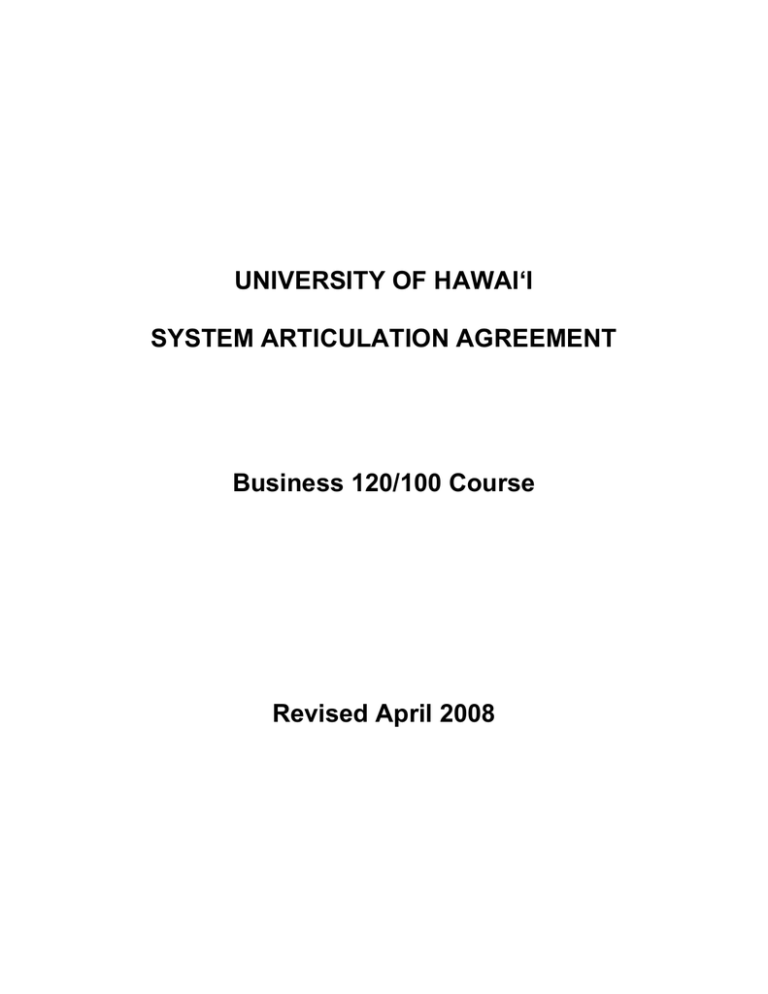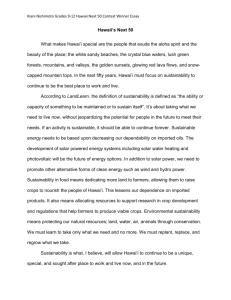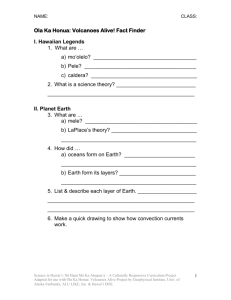
UNIVERSITY OF HAWAI‘I
SYSTEM ARTICULATION AGREEMENT
Business 120/100 Course
Revised April 2008
UNIVERSITY OF HAWAI‘I SYSTEM ARTICULATION AGREEMENT
Business Program
INTRODUCTION
The University of Hawai‘i is comprised of ten campuses located on four islands in the State of
Hawai‘i. While each campus has a unique identity and mission, the ten campuses operate as
one system.
Career Pathways
The State of Hawai‘i and its educational systems are participating in Career Pathways with an
overall theme of “Six pathways, one system.” The six pathways are:
4. Industrial and Engineering Technology
1. Arts and Communication
5. Natural Resources
2. Business
6. Public and Human Services
3. Health Services
At the secondary and postsecondary levels, the goal of Career Pathways is to provide
curriculum standards that meet business and industry requirements. Implementing these
standards will ensure student attainment of a high level of academic and technical skills, a
seamless transition from secondary to postsecondary educational programs and between
postsecondary campuses, and a satisfying career for which the student is well prepared.
Hawai‘i P-20 Initiative
The overarching goal of the P-20 initiative is to improve student achievement at all levels of
education. To this end, two of the goals of P-20 are:
1. To align standards, curricula, and assessments across all components of the state’s
public education system.
2. To improve transition among the components of the education system, as well as from
an educational setting to the workforce.
During the course of their education, students may decide to transfer from one campus to
another in the University of Hawai‘i (UH) system. The development of an articulated program of
study supports the transfer of earned academic credits within the UH system.
PURPOSE
The primary purpose of this articulation agreement is to facilitate the matriculation of students
and the transfer of courses across the university system. Moreover, it is intended to inform
students, whose program of study requires business courses as part of their degree
requirements, of the program opportunities that are available to them throughout the UH
system.
AGREEMENTS AND PROCEDURES
1. Scope of Agreement. This Articulation Agreement applies among the UH
Community Colleges and the University of Hawai‘i at Hilo.
2. Number of Credits to be Awarded. Transfer credit among University of Hawai‘i
campuses for the following courses:
University of Hawai‘i System Articulation Agreement
Business 120/100 Course
Page 2 of 15
Rev. April 8, 2008
UH
Hilo
Principles of Business
or
Introduction to Business
Hawai‘i
CC
Kapi‘olani
CC
Kauai
CC
Leeward
CC
Maui
CC
BUS
120
BUS
120
BUS
120
BUS
120
BUS
120
BUS
100
3. General Guidelines for the Application and Award of Transfer Credits
A. Student Eligibility: Students must be currently enrolled at a participating UH
campus to be eligible for the award of any transfer credit.
B. Timeline for Application: Students should apply for transfer credits during their
first year of attendance at the receiving campus.
C. Transferability: Credits awarded within the guidelines established in this
Agreement will transfer between and among designated University of Hawai‘i
campuses. However, students should be informed by both "sending" and
"receiving" campuses that transferred credits may not be applicable to programs
outside of this Agreement.
D. Campus Procedures: Each UH campus which is a party to this Agreement will
be responsible for establishing procedures which detail the timeline and
deadlines for application, review of requests for award of transfer credit, and the
appeals process for such credit.
Award of Credit through Credit-By-Examination. BUS 120, Principles of
Business, (Hawai‘i CC, Kapi‘olani CC, Kaua‘i CC, Leeward CC, and Maui CC) and
BUS 100, Introduction to Business (University of Hawai‘i at Hilo) as identified in this
Agreement will be eligible for credit-by-exam for those currently enrolled students
wishing to receive college credit for prior learning/experience obtained outside of the
University of Hawai‘i system. Each campus will establish procedures and administer
the standardized exam, which will be a written, objective test. Students interested in
challenging one of these courses through credit-by-examination must earn a score
equivalent to or greater than 70% in order to have their credits recognized by other
campuses in this Agreement. Students must follow the receiving campus’ guidelines
for applying for credit-by-examination. Once credits are awarded, they are
transferable among campuses listed in this Agreement provided they conform to the
scoring standards listed above.
The table in this document lists the courses which are equivalent within the
University of Hawai‘i system. If a course is unique to a campus and, hence, does
not have an equivalent course within the UH system, then it is not listed in the table.
Also, the course outline in this document has been approved by the faculty and
administrations of all campuses represented in this signed Agreement.
This Articulation Agreement will remain in effect until August 2012. It will be subject to
review in Fall 2011, and may be continued, revised, or discontinued with the consent of
all faculty members and administration of all campuses represented in this Agreement.
The Articulation Agreement remains in effect while review continues.
University of Hawai‘i System Articulation Agreement
Business 120/100 Course
Page 3 of 15
Rev. April 8, 2008
BUS 120 Principles of Business or (UHCCs)
BUS 100 Introduction to Business (UHH)
Course Outline
Revised 4/8/08
A. Course description
HawCC and KauCC: Surveys the fundamentals of American business enterprise.
Treats the foundations and responsibilities of business, management, finance,
and marketing; and the legal, government, and social environment.
KapCC: BUS 120 focuses on in depth analysis of and perspective to the role of a
business enterprise in a capitalistic society with emphasis on the functional
processes of a business and of the force fields that affect the modes of business
behavior. Course requirements will include examinations and a research project.
KauCC: Foundations of the social, legal, competitive, and economic environment of
business organizations within a capitalistic society and within the international
marketplace. Fundamentals of the importance of the internal organizational
structure, effective information systems, planning, management, and how the key
functions of business organizations, such as human resources administration, labor
management relations, marketing, finance, insurance, and accounting operate within
organizations.
LeeCC: In depth analysis of the functional processes & the role of a business
enterprise in a capitalistic society. This course is a requirement for all ACC and
BUSN Associate Degree Programs, and may also be used as an elective for the
Liberal Arts A.A. program.
MauCC: Surveys the fundamentals of American business enterprise. Treats the
foundations and responsibilities of business, management, finance, marketing, and
the legal, government, and social environment.
UHH: A study of business functions, methods of business operation, types of
business ownership, and the role of business organizations in contemporary society.
Effective Fall 2009, each University of Hawai‘i system campus offering this
course has agreed to:
Course description: Surveys the fundamentals of the American business enterprise.
Examines the foundations and responsibilities of accounting, business,
management, finance, marketing, and the business environment.
B. Hours per week
Lecture 3 hours
Lab _____ Other _____
University of Hawai‘i System Articulation Agreement
Business 120/100 Course
Total 3 hours
Page 4 of 15
Rev. April 8, 2008
C. Prerequisites, or required preparation:
HawCC: ENG 21 or placement in ENG 102; and ENG 22 or ESL 15 or placement in
Eng 100
KapCC: No prerequisites.
KauCC: No prerequisites.
LeeCC: Minimum grade of C in English 21 or 22, or equivalent, or instructor’s
approval.
MauCC: ENG 19 with grade C or better, or placement of ENG 22 or 55, or consent.
Recommended Preparation: ENG 22 or 55 with grade C or better, or placement of
ENG 100.
UH Hilo Admission Requirement: Refer to college catalog.
D. Intended Student Learning Outcomes
1. Demonstrate qualitative understanding of the impact of external factors on
business decisions relative to the accomplishment of the mission and objectives
of an organization.
2. Demonstrate qualitative understanding of various forms of business ownership to
determine their appropriateness relative to an organization’s resources, goals,
and objectives.
3. Demonstrate qualitative understanding of various business functions and
practices and their impact on the successful operation of a business.
4. Demonstrate qualitative understanding of the impact of business decisions on the
external environment.
E. Course content, including approximate time to be spent on each topic.
Concepts
SLO #1: Demonstrate qualitative understanding of the impact of external factors on
business decisions relative to the accomplishment of the mission and objectives of
an organization.
1. Stakeholders (e.g. customers, employees, vendors, owners, shareholders/
stockholders)
2. External environment, including:
a. Environmental (natural resources)
b. Economic
(1)
Gross National Product (GNP)
(2)
Gross Domestic Product (GDP)
(3) Capitalism, Socialism, Communism
(4) Free enterprise system
(5) Free-market economies
(6) Planned economies
(7) Mixed economies
University of Hawai‘i System Articulation Agreement
Business 120/100 Course
Page 5 of 15
Rev. April 8, 2008
(8)
(9)
(10)
(11)
(12)
(13)
(14)
Inflation/ Deflation
Supply and demand (effects on price and profitability)
Depression
Business cycle (recovery and recession)
Monetary policy
Fiscal policy
Factors of production (capital, enterprise, labor, physical
resources such as land, and information resources)
c. Socio cultural (social trends and issues)
d. Political (local, regional, national, international)l, legal, technological)
e. Types of competition
(1) Monopoly
(2) Oligopoly
(3) Monopolistic competition
(4) Pure or perfect competition
f. Technological
SLO #2: Demonstrate qualitative understanding of various forms of business
ownership to determine their appropriateness relative to an organization’s resources,
goals, and objectives.
3. Evolution of business in the United States
a. Factory system and the Industrial Revolution
b. Laissez-Faire and the Entrepreneurship Era
c. The Production Era
d. The Marketing Era
e. The Global Era
f. The Information Era
5. International business (e.g. multinational, global, absolute vs. comparative
advantage, import/export, tariffs, embargos, quotas, exchange rates, levels
of international investment [risk/return], cultural influences, challenges and
ethical considerations relative to international trade—North American Free
Trade Agreement (NAFTA) and other free trade agreements)
6. Forms of business ownership—current trends and characteristics for profits
and non-profits (e.g. entrepreneurship, small business, franchising, sole
proprietorship, partnerships, cooperatives, corporation [stockholders or
shareholders, types of stocks, board of directors, officers such as chief
executive officer], limited liability corporations, limited liability partnerships,
et. al.)
SLO # 3: Demonstrate qualitative understanding of various business functions and
practices and their impact on the successful operation of a business.
4. Human resource management (e.g. human resources, human resource
planning—job analysis, job description, job specification, performance
appraisals; performance tests, physical ability test, personality tests, drug
tests, labor relations, labor markets, unions, civil rights, sexual harassment,
EEO, staffing, compensation, training, laws that protect employee’s rights)
University of Hawai‘i System Articulation Agreement
Business 120/100 Course
Page 6 of 15
Rev. April 8, 2008
7.
Accounting and financial statements (e.g. use of Generally Accepted
Accounting Principles [GAAP], Certified Public Accountants [CPA], financial
statements—income statement and balance sheet—for ratio analysis)
a. Assets
h. Expenses
b. Liabilities
i. Operating costs
c. Owners’ Equity
j. Income Statement Equation
d. Liquidity
k. Liquidity Ratio
e. Intangible asset
l. Profitability Ratios
f. Accounting Equation
m. Activity Ratios
g. Sales Revenues
n. Break-even point
8. Finance (e.g. monetary systems, Federal Reserve, banking, loans—
unsecured, secured, collateral, line of credit; working capital, common stock,
debt, blue chip stocks, growth stocks, income stocks, etc.)
9. Securities markets (high returns, risky investments, price-to-warnings ratio)
10. Marketing (e.g. marketing mix—product, pricing, distribution [place],
promotion; product mix, new product development, innovation, product life
cycle—introduction, growth, maturity, decline; branding, packaging, labeling,
pricing, competitors, market share, marketing strategy—mass market, focus
group, target market, personal selling, mission statement, property rights—
patents, trademarks, copyright; distribution mix—intermediaries,
wholesalers, retailers, licensed distributors or dealers, franchising, direct
distribution, outsourcing, prospects, referrals; Customer Relationship
Management system)
11. Role of information technology in business effects of Intranet, Internet,
World Wide Web, etc., on business (global, reliability, accuracy, information
overload, timeliness, real time; positions such as Chief Information Officer,
webmaster)
12. Management theories (including Maslow’s Hierarchy of Needs, equity,
expectancy, Total Quality Management or TQM) and functions (e.g. leading,
motivating—reward, coercive expert, referent power, staffing, planning,
organizing, directing, controlling)
a. Organizational chart
b. Assigning tasks: responsibility and authority
c. Performing tasks: delegating and accountability
d. Distributing authority: centralization and decentralization
e. Forms of authority
f. Organizational structure (tall, flat, chain of command, centralization,
decentralization, functional, divisional, matrix, geographical,
international, team—group cohesiveness, communication [active
listening, transmit and share information], brainstorming, virtual,
learning, cross-functional)
g. Organizational culture (shared values, norms, beliefs and feelings)
SLO #4: Demonstrate qualitative understanding of the impact of business decisions
on the external environment.
13. Ethics/social responsibility (e.g. product safety; environmental responsibility;
employment practices such as grievances, whistle blowing; ethical and
University of Hawai‘i System Articulation Agreement
Business 120/100 Course
Page 7 of 15
Rev. April 8, 2008
unethical behaviors; insider trading; code of ethics; ethical dilemma;
conflicts of interest; protected consumer rights, warning labels)
Skills
1. Locate information.
2.
Distinguish relevant and reliable information.
3.
Identify and describe opportunities and threats posed by external variables
considered in decision making.
4. Identify the distinguishing characteristics of various forms of business ownership
5.
Recognize the benefits, risks, and potential consequences in choosing among
the various forms of organization.
6. Describe the basic principles, theories, and activities in each of the functional
areas of a business.
7.
Explain how the functional areas of a business are interrelated
8. Recognize positive and negative examples of socially responsible behavior in
business.
9. Apply relevant moral and ethical standards given a specific business situation.
F. Text and materials:
Varied, but may include:
• Bovée, Courtland L. and Thill, John V. 2006. Business in Action, 3rd Edition.
Pearson Prentice Hall. (0-13-019266-7)
• Boone, Louis E. and Kurtz, David L. 2006. Contemporary Business.
Thomson/South-Western Publishing Company. (0-324-32089-2)
• Jones, Gareth R. 2007. Introduction to Business: How Companies Create
Value for People. McGraw-Hill Publishing Company. (13-978-0-07-352456-6)
• Ferrell, O. C.; Hirt, Geoffrey; and Ferrell, Linda. 2008. Business: A Changing
World. McGraw-Hill Irwin Publishing. (978-0-07-351166-5)
G. Reference materials:
Varied, but may include:
• The Wall Street Journal
• Current events from various newspapers
• Business trade journals
• Magazines
H. Auxiliary materials and content:
Varied, but may include:
• Articles and handouts prepared by the instructor
• Magazine and newspaper articles
• Films, videos, or Internet sites
• Television programs
• Guest speakers
I. Learning Assessment Tasks:
1. Use a state-wide standardized comprehensive final exam.
2.
Use objective tests, scenarios, essay questions, or research/term papers, to
explain why external factors should be considered and their potential impact on
business decisions or success.
University of Hawai‘i System Articulation Agreement
Business 120/100 Course
Page 8 of 15
Rev. April 8, 2008
3.
4.
5.
Use objective tests, scenarios, essay questions, or research/term papers to
compare and contrast differences between forms of ownership.
Use objective tests, scenarios, essay questions, or research/term papers to apply
functional principles and theories to specific business situations.
Use objective tests, scenarios, essay questions, or research/term papers to
demonstrate application of relevant moral and ethical standards in business
situations.
J. Methods of instruction
Instructional methods vary considerably with instructors and specific instructional
methods will be at the discretion of the instructor teaching the course. Suggested
techniques may include, but are not limited to
1. Quizzes and tests with feedback and discussion.
2. Lectures and class discussion.
3. Problem solving.
4. PowerPoint presentations.
5. Videos, DVDs, CD-ROMs.
6. Guest speakers.
7. Group activities.
8. Oral reports and other student presentations.
9. Games and simulations.
10. Homework assignments such as
- Reading, or watching, and writing summaries and reactions to marketing
issues in the media including newspapers, video, magazines, journals;
- Lectures, web-based materials, and other sources;
- Analyzing published business plans;
- Reading text and reference materials and answering discussion questions;
and
- Research environmental problems and issues.
11. Web-based assignments and activities.
12. Reflective journals.
Per Attachment V, CCCM # 6100 (Revised August 28, 1991)
and The Outcomes Primer by Ruth Stiehl, pp. 46-47, ©2002
University of Hawai‘i System Articulation Agreement
Business 120/100 Course
Page 9 of 15
Rev. April 8, 2008









